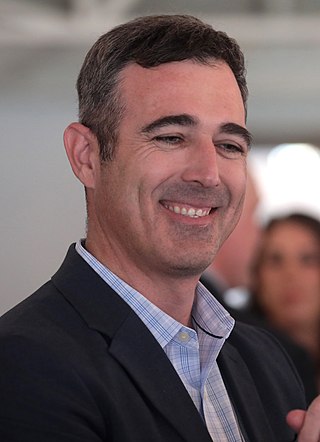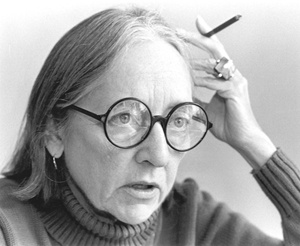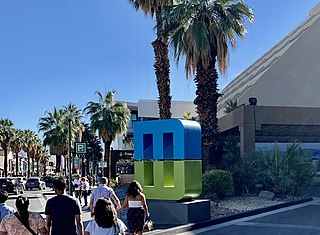Related Research Articles

Tucson is a city in and the county seat of Pima County, Arizona, United States, and is home to the University of Arizona. It is the second-largest city in Arizona behind Phoenix, with a population of 542,629 in the 2020 United States census, while the population of the entire Tucson metropolitan statistical area (MSA) is 1,043,433. The Tucson MSA forms part of the larger Tucson-Nogales combined statistical area. Both Tucson and Phoenix anchor the Arizona Sun Corridor. The city is 108 miles (174 km) southeast of Phoenix and 60 mi (100 km) north of the United States–Mexico border.

The International Style is a major architectural style and movement that began in western Europe in the 1920s and dominated modern architecture until the 1970s. It is defined by strict adherence to functional and utilitarian designs and construction methods, typically expressed through minimalism. The style is characterized by modular and rectilinear forms, flat surfaces devoid of ornamentation and decoration, open and airy interiors that blend with the exterior, and the use of glass, steel, and concrete.

Unity Temple is a Unitarian Universalist church in Oak Park, Illinois, and the home of the Unity Temple Unitarian Universalist Congregation. It was designed by the American architect Frank Lloyd Wright, and built between 1905 and 1908. Unity Temple is considered to be one of Wright's most important structures dating from the first decade of the twentieth century. Because of its consolidation of aesthetic intent and structure through use of a single material, reinforced concrete, Unity Temple is considered by many architects to be the first modern building in the world. This idea became of central importance to the modern architects who followed Wright, such as Ludwig Mies van der Rohe, and even the post-modernists, such as Frank Gehry. In 2019, along with seven other buildings designed by Wright in the 20th century, Unity Temple was added to the UNESCO World Heritage List.

The Hotel Congress is a federally recognized historic building located in downtown Tucson, Arizona. It was built in 1918 and designed by the Los Angeles architectural firm William and Alexander Curlett as part of an expansion of Congress Street and in conjunction with the theatrical venue Rialto Theatre, which sits north of Congress Street. The rear of the building faces the historic Amtrak Southern Pacific train station, built by Southern Pacific in 1907. In addition to being a hotel, the Hotel Congress building also houses a restaurant, bar and music venue. The name "The Congress Hotel" was chosen through a naming competition organized by the Arizona Daily Star newspaper in 1918. The winning suggestion was announced on April 30, 1918, and it was submitted by Dorit Dinkel, who won $15 worth of baby bonds for having their name chosen. The Hotel Congress and its owners since 1985, Richard Oseran and Shana Oseran, have been a key cultural institution and boosters in the early 21st-century redevelopment of Downtown Tucson.
Josias Thomas Joesler was a Swiss-American architect who later worked and eventually died in Tucson, Arizona.
Henry O. Jaastad (1872–1965) was an influential Tucson, Arizona architect. His firm created over 500 buildings and Jaastad was Mayor of Tucson for 14 years. A number of his works are listed on the U.S. National Register of Historic Places for their architecture.

Annie Graham Rockfellow was an influential and prolific architect active in Tucson, Arizona during the first half of the 20th century.

The Museum of Contemporary Art (MOCA) in Tucson, Arizona, United States, was founded in 1997, by Julia Latané, James Graham, and David Wright. The museum was founded to create a permanent institution for contemporary art in Tucson's arts district. Originally housed in the HazMat building on Toole Avenue, the museum relocated to the former fire department building on Church Avenue in 2010.

David Tineo is an American artist of Mexican descent whose works focus on cultural and identity issues particular to Mexican Americans who live in the U.S. Though internationally known, most of Tineo's life and career has been spent in Tucson, Arizona. He was diagnosed in 2004 with a macular degeneration that left him legally blind, but continues to paint and sculpt.

Demion Clinco is an American politician, historic preservationist, philanthropist, and business leader from the state of Arizona. Clinco's social innovation included reestablishing the Tucson Historic Preservation Foundation in 2008 and launching Tucson Modernism Week in 2012 and work in the higher-education sector. A member of the Democratic Party, Clinco served in the Arizona House of Representatives, as a member for the second district until 2015. In December 2015 Clinco was appointed to the Governing Board of Pima Community College. Clinco was elected in 2016 to serve a full term and in January 2018 was elected chairman of the college's Governing Board. Under Clinco's leadership the college initiated large-scale bond projects focusing on workforce development and career technical education. During this period the college underwent a significant educational and physical transformation with the construction of major buildings including Centers of Excellence in applied technology, advanced manufacturing, automotive, aviation, and allied health. In 2019 Clinco relaunched and led the reorganization of the Arizona Association of Community College Trustees serving as the president. Clinco has served on numerous local, statewide, national and international boards.

The Tucson Museum of Art and Historic Block (TMA) is an art museum and art education institution located in the Presidio District of downtown Tucson, Arizona. The museum comprises 74,000-square-feet of exhibition space over a four-acre city block that includes a contemporary main museum and 19th C. historic homes, including the Cordova House (1848), that have been adapted for reuse as the museum restaurant, pottery school, and galleries.

Judith Chafee was an American architect known for her work on residential buildings in Arizona and for being a professor of architecture at the University of Arizona. She was a recipient of the National Endowment of the Arts Fellowship to the American Academy in Rome during the middle of her career and was the first woman from Arizona to be named a Fellow of the American Institute of Architects.

The Tucson Historic Preservation Foundation is a private, nonprofit organization dedicated to the preservation of the historic, architectural, as well as cultural heritage of Tucson, Arizona. Through advocacy initiatives, educational programs, architectural resources, and cultural events, the foundation’s goal is to encourage the community to learn about and preserve the historic buildings that make the Tucson and Pima County unique.

Hirsh's Shoes is a Mid-Century modern store building located in Tucson, Arizona, United States. Designed in 1954 by Jewish-American architect Bernard "Bernie" Friedman for entrepreneur Rose Hirsh, the open plan storefront is an iconic retail standard. Rose C. Hirsh hired Friedman to design this building as a free standing shop in what would become an early strip mall. Though now surrounded by other buildings, it was owned and operated by the Hirsh Family from its construction in 1954 until 2016. The opening of the store was featured in the Arizona Daily Star on April 7, 1954 and for 62 years the Hirsh Family maintained the character-defining architectural features of the north facade and unique architectural expression that defined the mid-century era. In 2014 the Hirsh Family restored the roof mounted neon sign.

Modernism Week is a 501(c)(3) organization which provides public education programming fostering knowledge and appreciation of modern architecture, the mid-century modern architecture and design movement, the Palm Springs School of Architecture, as well as contemporary considerations surrounding historic preservation, cultural heritage, adaptive reuse, and sustainable architecture. Modernism Week provides annual scholarships to local students pursuing college educations in the fields of architecture and design and supports local and state organizations' efforts to preserve and promote the region's modern architecture. The organization is centered in the greater Palm Springs, California area in the Coachella Valley which is home to a significant collection of extant residential and commercial buildings designed in the mid-century modern vernacular.
James Pringle Cook is an American painter based in Tucson, Arizona, known nationally for expressive, monumental landscapes and urban scenes that employ vigorous brushwork and thick, impasto surfaces and move between realism and passages of abstraction. He has explored a wide range of geographies across the United States and subjects from craggy mountains and seascapes to industrial accidents to the figure. Curators and critics, however, generally agree that his work is as much about pure painting as it is about his convincing recapitulations of the world and a sense of place. Museum Director Robert Yassin described Cook as "a painter who is in love with painting [whose] bravura use of paint is akin to the abstract expressionists; unlike them, however, he provides viewers with a recognizable reality, ordered by his own personal vision and controlled by his technical mastery." Discussing his urban works, Margaret Regan wrote, "Cook is so skilled a painter he can turn almost anything into a thing of beauty […] His bravura handling of the paint is what matters: his pure layers of color, slabbed in thick gobs onto his linen canvases with a palette knife, glistening like butter."

Bailey Doogan was an American artist best known for her large-scale, feminist paintings and drawings that offer an unflinching look at the aging, female body and that tackle cultural issues like the equation of beauty with youth. Doogan's artwork has been reviewed in numerous publications, including Art in America, The Nation, Art Journal, Ms., ARTnews and the New Art Examiner. Her work also has been reproduced in Harper's Magazine.

Photo L.A. is an international art photography fair held annually in Los Angeles. The fair was established in 1992 and is visited by between ten and eighteen thousand attendees annually.
Andy Burgess is a British artist based in Tucson, Arizona. He is best known for his abstract depiction of modernist architecture, in particular for mid-century modern homes. Likened to David Hockney, Burgess describes his style as "Pop Geometry".
Bernard J. Friedman was an American Jewish architect whose work helped shape Tucson's mid-century modern commercial design.
References
- 1 2 Barchfield, Vanessa. "Tucson Modernism Week Showcases City's Mid-Century Modern Heritage". news.azpm.org.
- ↑ Regan, Margaret. "Everything Old Is New". Tucson Weekly.
- ↑ Trebay, Guy (12 June 2015). "In Tucson, an Unsung Architectural Oasis". The New York Times.
- ↑ "Large desert flower one attraction of Tucson Modernism Week".
- ↑ Regan, Margaret. "Celebrating Swaim". Tucson Weekly.
- ↑ Gay, Gerald M. "Modernism Week steps up its virtual offerings in 2020". Arizona Daily Star.